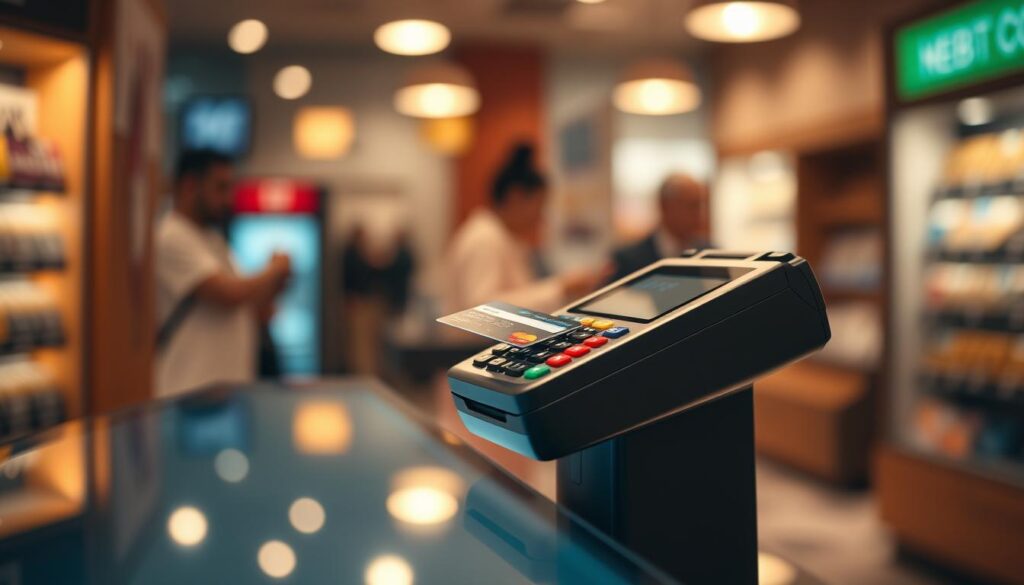In a world where financial freedom and control are paramount, understanding the debit card process is a crucial step towards empowerment. As someone who has navigated the complexities of personal finance, I know firsthand the importance of grasping the intricacies of debit payment processing. At Revolution Money Exchange, we are committed to providing you with the knowledge and tools necessary to take charge of your financial future.
With debit cards accounting for 28% of all payments, it’s essential to understand the series of steps involved in a debit card transaction. From the moment you swipe or insert your card to the funds being deposited into the merchant’s account, the debit card process may seem straightforward, but it involves a complex interplay of various parties and technologies. By familiarizing yourself with the debit card payment procedure, you can make informed decisions and ensure the security of your transactions.
The debit card process is a real-time system that allows for quick fund transfers, usually within 24 to 48 hours. This speedy processing time sets debit cards apart from other payment methods, such as ACH transactions, which can take 4 to 10 days. Additionally, debit cards are considered less prone to fraud compared to credit cards, making them a safer choice for both consumers and merchants.
Key Takeaways:
- Debit cards account for 28% of all payments
- Debit card processing involves a series of steps between the customer’s payment and the merchant receiving the funds
- Regulated banks have a set fee structure for debit card transactions, not exceeding 0.05% plus 21 cents per transaction
- Debit card processing is faster than ACH transactions, with funds deposited into the merchant account within 48 hours
- PIN debit transactions are the most common type of debit card transaction and are suitable for larger purchases
What is Debit Card Processing?
Debit card processing is the behind-the-scenes operations that enable businesses to accept debit cards as a form of payment. When a customer pays with a debit card, the funds are drawn directly from their existing bank account, unlike credit card transactions that rely on a credit line. In the United States, debit cards are the most popular payment method, accounting for 28% of total payments, while credit cards make up 27%.
Approximately half of all card payments made on eCommerce sites are processed through debit cards. The debit card payment process involves fewer parties compared to credit card processing, resulting in lower fees for merchants. This cost-effectiveness makes debit card processing an attractive option for businesses, especially small business merchants who can benefit from partnering with regulated banks that offer reduced interchange fees.
Understanding the Basics of Debit Card Transactions
Debit card transactions are considered less risky and have lower processing rates than credit cards due to reduced fraud and chargeback issues. When a customer makes a purchase using their debit card, the following steps occur:
- The customer’s card information is read by the merchant’s point-of-sale (POS) system
- The transaction details are sent to the payment processor for authorization
- The payment processor communicates with the card issuer to verify the availability of funds in the customer’s account
- Upon approval, the funds are deducted from the customer’s account and transferred to the merchant’s account
This streamlined debit card payment process ensures that businesses receive their funds quickly and securely, while customers enjoy the convenience of using their debit cards for purchases.
The Role of Payment Processors in Debit Card Processing
Payment processors play a crucial role in facilitating debit card transactions by serving as intermediaries between merchants, card networks, and financial institutions. They handle the complex task of reading card information, obtaining approval from the acquirer and card network, and transferring funds from the cardholder’s account to the merchant’s account.
Payment processors charge various fees based on their pricing structures, which may include interchange fees, transaction fees, and markup fees. Understanding these fees allows businesses to negotiate better rates and save on their debit card processing costs. Markup fees, in particular, are negotiable and can vary between different processors.
| Bank Type | Interchange Fee |
|---|---|
| Regulated banks (over $10 billion in assets) | 0.05% + $0.21 per transaction |
| Unregulated banks (less than $10 billion in assets) | Variable rates based on transaction size, merchant category code, and verification method (PIN or signature) |
By partnering with the right payment processor and understanding the fee structure, businesses can optimize their debit card processing costs and improve their bottom line.
How Debit Card Processing Works
Debit card processing is a complex system that involves multiple players and steps to ensure secure and efficient transactions. When a customer swipes their debit card at a point-of-sale (POS) terminal, the process of debit card payment begins. The POS system reads the card information and securely transmits the data to the card processing network for verification.
Step-by-Step Guide to the Debit Card Payment Process
Here’s a step-by-step breakdown of the debit card payment process:
- The customer presents their debit card at the merchant’s POS terminal.
- The POS system reads the card information and sends a request to the card processing network.
- The card processing network verifies the card details and forwards the request to the issuing bank.
- The issuing bank confirms that the customer has sufficient funds in their account.
- The issuing bank sends an approval or decline message back through the card processing network.
- The card processing network relays the response to the merchant’s POS system.
- If approved, the transaction is authorized, and the funds are deducted from the customer’s account.
- The merchant completes the sale and provides the customer with a receipt.
This entire process typically takes just a few seconds, thanks to the advanced technology and robust infrastructure of the payment processing system. The funds are then settled and deposited into the merchant’s account, usually within 24 to 48 hours.
Key Players Involved in Debit Card Processing
Several key players are involved in the debit card payment process, each with a specific role:
| Key Player | Role |
|---|---|
| Cardholder | The customer who presents the debit card for payment |
| Merchant | The business accepting the debit card payment |
| Issuing Bank | The bank that issued the customer’s debit card |
| Card Processing Network | The network that facilitates communication between the merchant and issuing bank (e.g., Visa, Mastercard) |
| Payment Processor | The company that handles the technical aspects of processing the transaction |
By understanding the debit card payment process and the roles of the key players involved, businesses can ensure smooth and secure transactions for their customers.
Types of Debit Card Transactions
When it comes to making purchases with a debit card, there are several types of transactions to be aware of. Each type of debit card transaction has its own unique characteristics and processing methods.
PIN Debit Transactions
PIN debit transactions require the customer to enter their Personal Identification Number (PIN) at the point of sale. These transactions are processed through banking networks, providing an extra layer of security. PIN entry is required for cardholders with chip cards when making transactions.
Signature Debit Transactions
Signature debit transactions, also known as “run as credit” transactions, are processed through credit card networks. Customers sign a receipt to authorize the purchase, similar to a credit card transaction. These transactions may offer rewards programs, such as 1% cash back on purchases, akin to credit card benefits.
Contactless Debit Transactions
Contactless debit transactions utilize Near Field Communication (NFC) technology, allowing customers to tap their debit card or mobile device on a compatible terminal. This method offers a quick and convenient payment option, gaining popularity among consumers.
Card-Not-Present Debit Transactions
Card-not-present debit transactions occur when the physical card is not available, such as online purchases or over-the-phone payments. These transactions are processed through credit networks but carry a higher risk of fraud compared to in-person transactions.
It’s important to note that debit card transactions may have daily purchase limits to restrict spending within a 24-hour period. Additionally, insufficient funds or non-sufficient funds (NSF) fees may be incurred if purchases exceed the available balance in the account.
Debit Card Processing Time
When it comes to making payments, speed is of the essence. Debit card processing time is incredibly fast, with transactions typically taking just seconds to complete. From the moment you swipe or tap your debit card at the merchant’s point-of-sale system, the payment request is sent through the processor to your issuing bank for approval. This lightning-fast process ensures a seamless and efficient payment experience.
Despite the speedy nature of debit card transactions, there are still some factors that can impact processing times. Security checks conducted by card issuers and payment networks, such as address verification and card authentication, are essential for protecting against fraud and unauthorized transactions. These additional measures may add a few extra seconds to the overall processing time, but they provide peace of mind and ensure the legitimacy of each transaction.

Once the transaction is approved, the funds are typically transferred from the issuing bank to the merchant’s account within 24 hours. However, in some cases, settlement procedures between the merchant’s acquiring bank and the cardholder’s issuing bank may take a bit longer to complete. Pending transactions, where the amount is set aside but not yet fully processed or settled, can last anywhere from a few days to up to a week, depending on factors like authorization holds, processing delays, and potential cardholder disputes.
To put debit card processing time into perspective, let’s compare it to other payment methods:
- Credit card payment processing times can take 24 hours to 3 days
- ACH payment processing time typically takes 3 business days
- Wire transfer payment processing times are 24 hours domestic and 1-5 days international
- Paper check processing times are usually between 24 and 48 hours
By choosing a reliable payment processor and optimizing payment gateway integration, businesses can ensure efficient debit card processing times. Faster and more reliable debit payment solutions enhance the customer experience, leading to increased satisfaction and loyalty. With over 85,000 businesses using platforms like GoCardless to improve payment processing, it’s clear that prioritizing speedy debit card transactions is a smart move for any business looking to streamline their payment operations.
Debit Card Processing Fees
When it comes to accepting debit card payments, businesses need to be aware of the various fees involved in the process. Debit card processing fees can vary depending on several factors, including the type of transaction, the card network, and the size of the card-issuing bank. Let’s take a closer look at the two main components of debit card processing fees: interchange fees and payment processor markup fees.
Interchange Fees for Regulated and Unregulated Banks
Interchange fees are the largest portion of debit card processing fees and are charged by card networks like Visa and Mastercard. These fees are paid to the card-issuing banks to cover the costs associated with processing transactions and managing fraud risk. The Durbin Amendment, which took effect in 2011, regulates interchange fees for banks with more than $10 billion in assets. These regulated banks can only charge a maximum of 0.05% plus 21 cents per transaction. On the other hand, unregulated banks with less than $10 billion in assets have more complex fee structures that can vary based on factors such as transaction size and merchant category code.
Payment Processor Markup Fees
In addition to interchange fees, payment processors also charge markup fees for their services. These fees can be structured in different ways, such as flat-rate, tiered, or interchange-plus pricing models. Flat-rate pricing typically involves a fixed percentage plus a per-transaction fee, while tiered pricing categorizes transactions into different levels with varying rates. Interchange-plus pricing is the most transparent model, where the processor passes on the interchange fee directly to the merchant and adds a fixed markup on top of it.
Here are some key statistics related to debit card processing fees:
- The average processing fee for debit card transactions is 34 cents in interchange plus the processor’s markup.
- Interchange fees for regulated debit card-issuing banks are capped at 0.05% plus 21 cents per transaction.
- Flat-rate payment processors charge around 2.6% plus 10 cents for in-person transactions.
- Businesses have merchant category codes affecting interchange rates, with higher rates for high-risk industries.
- Small businesses may pay around 2.7% + 5¢ in-person or 2.9% + 30¢ online using certain payment processors.
By understanding the various components of debit card processing fees and how they are calculated, businesses can make informed decisions when selecting a payment processor and negotiating rates. It’s essential to compare different pricing models and carefully review the terms and conditions to ensure that you are getting the best value for your business while providing a seamless payment experience for your customers.
Differences Between Debit Card and Credit Card Processing
While both debit card processing and credit card processing facilitate cashless transactions, there are significant differences in how these payments are handled behind the scenes. Understanding these distinctions is crucial for businesses to make informed decisions about accepting various payment methods and managing associated costs.
How Credit Card Processing Works
Credit card transactions involve an additional step compared to debit card processing. When a customer makes a purchase with a credit card, the payment data is first sent to the processor before reaching the card network and issuing bank. The processor then pays the merchant upfront and collects the funds from the customer later. This extra step adds complexity and cost to the process, with higher interchange fees and potential surcharges.
Credit cards also offer more flexibility for consumers, as they can make purchases up to their available credit limit and pay the balance over time, often with minimum payments and accrued interest. However, this flexibility comes with a higher perceived risk for processors and issuing banks, resulting in higher processing fees for merchants.
Comparing Debit Card and Credit Card Processing Flows
In contrast, debit card transactions are considered less risky, as the funds are directly debited from the customer’s bank account. This lower risk profile generally translates to lower processing fees for merchants. In the United States, the federal government has set a standard rate for debit card transactions processed by banks with more than $10 billion in assets, capping the fees at 0.05% + $0.21 per transaction.
Another key difference between debit and credit card processing is the dispute resolution process. Consumers can typically dispute credit card charges up to 120 days after the transaction, while they generally assume full responsibility for debit card charges if not disputed within 60 days of receiving a statement.
Despite these differences, both debit and credit card transactions follow the same basic three-step process: authorization, settlement, and funding. However, the involvement of additional financial entities and the perception of risk in credit card processing often result in higher fees for merchants compared to debit card processing.
As businesses navigate the world of cashless payments, it’s essential to understand the nuances of debit card processing and credit card processing to make informed decisions about which payment methods to accept and how to manage the associated costs while prioritizing customer satisfaction and loyalty.
Advantages of Debit Card Processing Over ACH Payments
When it comes to processing payments, businesses have various options to choose from, including debit card processing and ACH payments. While both methods have their advantages, debit card processing offers several benefits that make it a more appealing choice for many businesses.
One of the most significant advantages of debit card processing is the faster processing time. Debit card transactions typically take less than 48 hours to settle, whereas ACH payments can take anywhere from 1-3 business days, with options for faster transfers available at additional costs. This faster processing time can significantly improve cash flow for businesses, allowing them to access funds more quickly.
Another advantage of debit card processing is the reduced risk of returned transactions. When a customer makes a purchase using a debit card, the funds are verified immediately, ensuring that the transaction will be successful. In contrast, ACH transactions lack real-time authorization and may be returned due to insufficient funds or other issues, which can be costly and time-consuming for businesses to resolve.
Debit card processing also offers greater customer appeal compared to ACH payments. Debit cards are more commonly used by consumers and offer features like cashback rewards that ACH payments do not. This can make customers more likely to choose debit card payments over ACH, potentially increasing sales for businesses.
While ACH payments do have some advantages, such as lower transaction fees and the ability to process large volumes of payments in batches, they may not be the best choice for all businesses. ACH transactions typically incur fees ranging from pennies to a few dollars per transaction, while debit card transaction fees can range from 1.5% to 3.5% of the transaction amount, plus additional per-transaction charges.
Ultimately, the choice between debit card processing and ACH payments will depend on the specific needs and preferences of each business. However, for those looking for faster processing times, reduced risk of returned transactions, and greater customer appeal, debit card processing may be the better option.
Implementing Debit Card Processing for Your Business
As a business owner, offering debit card payments can significantly enhance your customers’ checkout experience and boost your bottom line. In 2022 alone, US businesses paid a record $160.7 billion in processing fees to accept over $10 trillion in payments from credit, debit, and prepaid cards. Implementing debit card processing is a smart move, as electronic payment systems can be more cost-effective than handling cash or checks, eliminating bank deposit fees, manual processing labor, and the need to physically transport money.

To get started with debit card processing, you’ll need to choose the right payment processor and set up your point-of-sale (POS) system accordingly. Here’s a step-by-step guide to help you navigate the process:
Choosing the Right Payment Processor
Selecting a payment processor is a crucial decision that can impact your business’s financial health. Consider the following factors when evaluating potential providers:
- Transaction fees, typically ranging from 1.5% to 3.5%
- Setup costs and hidden charges
- Security measures, such as PCI DSS compliance and fraud prevention
- Support for high transaction volumes and multiple currencies
- Integration with existing systems
- Customer support and uptime guarantees
Merchant account providers offer competitive pricing but have a more involved setup process, while payment service providers like PayPal have easy setup but higher long-term costs. Ultimately, the right processor depends on your business type and specific needs.
Setting Up Your POS System for Debit Card Acceptance
Once you’ve chosen a payment processor, it’s time to set up your POS system for debit card acceptance. This typically involves the following steps:
- Obtain the necessary hardware, such as a card reader or terminal
- Install and configure the payment processing software
- Train your staff on how to process debit card transactions
- Test the system to ensure smooth operation
To optimize your debit card processing setup, consider the following tips:
| Tip | Benefit |
|---|---|
| Offer a variety of payment options | Enhance the checkout experience and boost conversion rates |
| Leverage real-time insights and reporting | Monitor performance and optimize payment processes |
| Implement address verification service (AVS) | Lower interchange rates and reduce fraudulent transactions |
By carefully selecting your payment processor and setting up your POS system for debit card acceptance, you can streamline your payment processes, reduce costs, and provide a seamless checkout experience for your customers.
Debit Card Process: Consumer Perspective
From a consumer’s point of view, the debit card process offers a convenient and secure way to make payments without the need to carry cash. When you use your debit card, the funds are drawn directly from your checking account, providing a simple and straightforward payment method. In fact, debit cards have become the most widely used payment method in the United States, accounting for 28% of all transactions. According to industry data, 38% of consumers use debit cards for in-store purchases, while 33% use them for online payments.
How Consumers Benefit from Using Debit Cards
One of the main advantages of using a debit card is the ability to get cash back at the point of sale, eliminating the need to visit an ATM. Additionally, debit cards can help consumers better manage their spending and stick to a budget, as the funds are deducted immediately from their checking account. This real-time tracking of expenses can prevent overspending and help maintain financial control. With over 80% of Americans now using debit cards, the trend towards increased debit card usage continues to grow, highlighting the benefits and convenience they offer to consumers.
Debit Card Security Features
Debit card security is a top priority for consumers, and modern debit cards come equipped with advanced features to protect users’ financial information. EMV chip technology has significantly reduced the risk of counterfeit fraud, while contactless payments allow for secure transactions without the need to physically swipe or insert the card. Many debit card issuers also offer real-time transaction notifications, alerting consumers to any suspicious activity on their account. These security measures, combined with the convenience and budgeting benefits, make debit cards an attractive choice for consumers in the ever-evolving landscape of digital payments.
FAQ
What is debit card processing?
How does the debit card payment process work?
What are the different types of debit card transactions?
How long does debit card processing take?
What fees are associated with debit card processing?
How is debit card processing different from credit card processing?
What are the advantages of debit card processing over ACH payments?
How can a business implement debit card processing?
What are the benefits of using debit cards for consumers?
Source Links
- The Basics of Debit Card Processing – What It Is & How It Works – Plastiq
- How Does Debit Card Processing Work? – NerdWallet
- What Is Debit Card Processing And How Much Are The Fees?
- Debit Card Payments Processing: Flow, Fees and Technologies
- How payment transaction processing works | Stripe
- How Do Debit & Credit Card Transactions Work? | Kount
- Debit Card Definition, Fees, and How They Work
- Debit Card Processing: What Is It?
- Principles: Credit and Debit Card payments and processing
- How Long Do Debit Card Payments Take to Process?
- Guide to US Payment Processing Times
- Debit Card Processing Fees: A 2024 Guide for Small Businesses – NerdWallet
- Debit Card Processing Fees: Ultimate Guide for Sellers in 2023
- Debit Card Processing Fees (2024)
- Credit Vs Debit: Which Is Better For Online Payments?
- Credit vs. Debit Transactions: What’s the Difference? | Merchant Cost Consulting
- Credit vs Debit Transactions: What’s the Difference? [2023]
- A guide to ACH vs. card transactions | Stripe
- Why use ACH payments? Pros and cons
- A guide to payment processing for small businesses | Stripe
- The complete guide to credit card processing
- Processing Costs: Differences in Debit & Credit Cards
- What Is Credit Card Processing?
- 5 Must-Have Features for Loan Origination System



